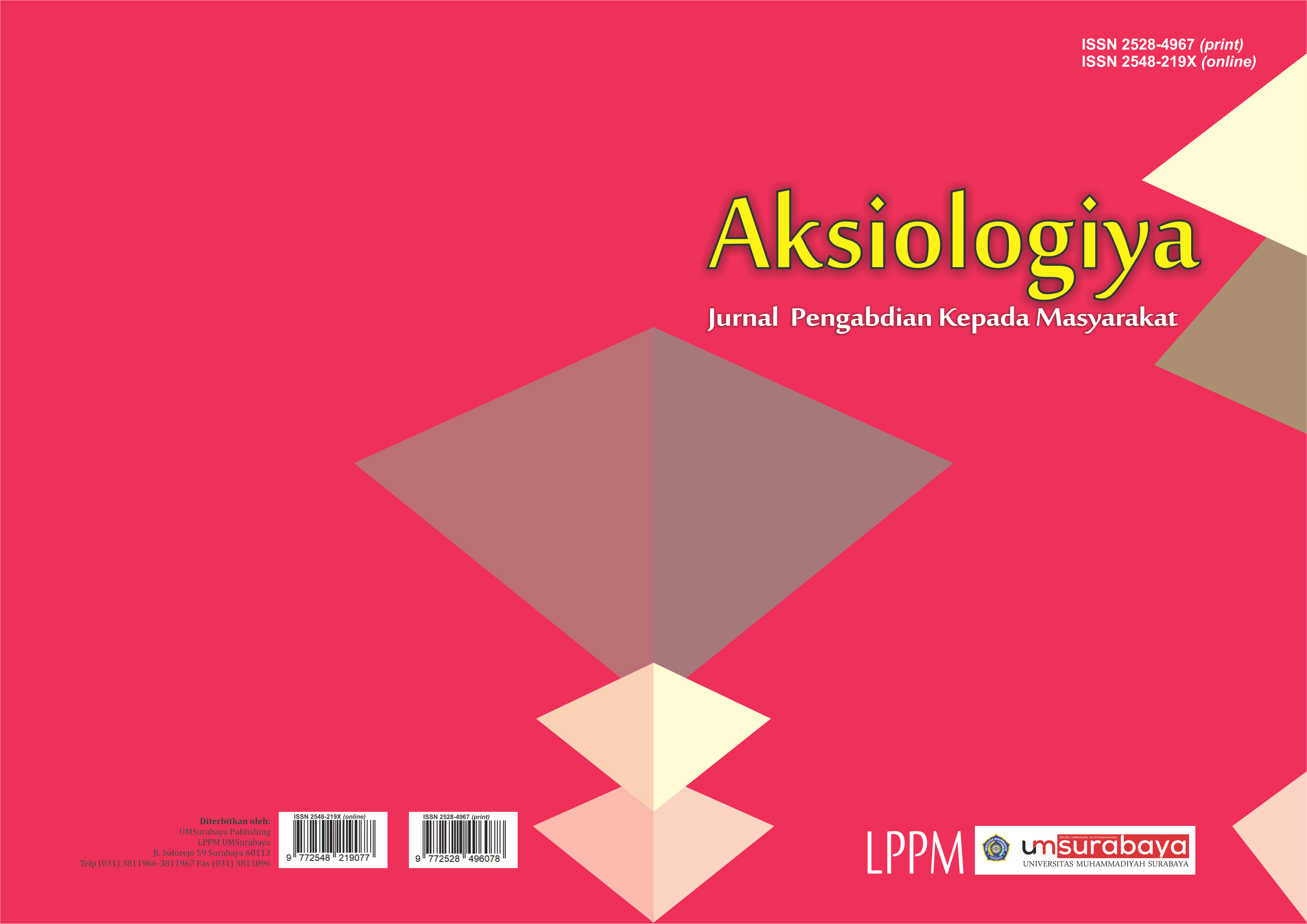Isi Artikel Utama
Abstrak
Kata Kunci
Rincian Artikel
Hak cipta artikel dimiliki oleh jurnal AKSIOLOGIYA
Ciptaan disebarluaskan di bawah Lisensi Creative Commons Atribusi-NonKomersial 4.0 Internasional.
Referensi
- Dewantoro, G. W. 2001. The Fecundify and Juveniles Products of Fighting Fish (Betta splendens Regan) With Different Age and Natural Food. Jurnal Iktiologi Indonesia. l(2): 49–52.
- Arfah, H., Soelistyowati, D. T., Bulkini, A. 2013. Maskulinisasi ikan cupang Betta splendens melalui perendaman embrio dalam ekstrak purwoceng Pimpinella alpina. Jurnal Akuakultur Indonesia, 12(2): 144–149.
- Kusumah, R. V., Murniasih, S., Kusrini, E., Cindelaras, S. 2015. Keragaan Generasi Pertama Hasil Persilangan Cupang Alam (Betta imbellis) Dengan Cupang Hias. Prosiding Indoaqua-Forum Inovasi Teknologi Akuakultur. 1273–1286.
- Prasadi, O., Setyobudiandi, I., Butet, N. A., & Nuryati, S. (2016). Karakteristik Morfologi Famili Arcidae di Perairan yang Berbeda ( Karangantu dan Labuan , Banten ) Characteristics Morphologically of Family Arcidae in Different Coastal Waters ( Karangantu and Labuan , Banten ). Jurnal Teknologi Lingkungan, 17(1), 29–36. Retrieved from http://ejurnal.bppt.go.id/index.php/JTL/article/viewFile/1462/1254
- Rachmawati, D., Basuki, F., Yuniarti, T. 2016. Pengaruh Pemberian Tepung Testis Sapi Dengan Dosis Yang Berbeda Terhadap Keberhasilan Jantanisasi Pada Ikan Cupang (Betta sp.). Journal of Aquaculture Management and Technology. 5(1): 130–136.
- Rahmawati, R., Cindelaras, S., Kusrini, E. 2016. Keragaan Pertumbuhan dan Warna Ikan Wild Betta (Betta sp.) dengan Rekayasa Intensitas Cahaya dan Warna Latar. Jurnal Riset Akuakultur. 11(2): 155–162.
- Taviv, Y., Saikhu, A., Sitorus, H. 2010. Pengendalian DBD Melalui Pemanfaatan Pemantau Jentik dan Ikan Cupang di Kota Palembang. Buletin Penelitian Kesehatan. 38(4): 215–224.
- Yustina, A., and Ariani, D. 2012. Efektivitas Tepung Teripang Pasir (Holothuria scabra) Terhadap Maskulinisasi Ikan Cupang (Betta splendens). Jurnal Biogenesis. 9(1): 37–44.
Referensi
Dewantoro, G. W. 2001. The Fecundify and Juveniles Products of Fighting Fish (Betta splendens Regan) With Different Age and Natural Food. Jurnal Iktiologi Indonesia. l(2): 49–52.
Arfah, H., Soelistyowati, D. T., Bulkini, A. 2013. Maskulinisasi ikan cupang Betta splendens melalui perendaman embrio dalam ekstrak purwoceng Pimpinella alpina. Jurnal Akuakultur Indonesia, 12(2): 144–149.
Kusumah, R. V., Murniasih, S., Kusrini, E., Cindelaras, S. 2015. Keragaan Generasi Pertama Hasil Persilangan Cupang Alam (Betta imbellis) Dengan Cupang Hias. Prosiding Indoaqua-Forum Inovasi Teknologi Akuakultur. 1273–1286.
Prasadi, O., Setyobudiandi, I., Butet, N. A., & Nuryati, S. (2016). Karakteristik Morfologi Famili Arcidae di Perairan yang Berbeda ( Karangantu dan Labuan , Banten ) Characteristics Morphologically of Family Arcidae in Different Coastal Waters ( Karangantu and Labuan , Banten ). Jurnal Teknologi Lingkungan, 17(1), 29–36. Retrieved from http://ejurnal.bppt.go.id/index.php/JTL/article/viewFile/1462/1254
Rachmawati, D., Basuki, F., Yuniarti, T. 2016. Pengaruh Pemberian Tepung Testis Sapi Dengan Dosis Yang Berbeda Terhadap Keberhasilan Jantanisasi Pada Ikan Cupang (Betta sp.). Journal of Aquaculture Management and Technology. 5(1): 130–136.
Rahmawati, R., Cindelaras, S., Kusrini, E. 2016. Keragaan Pertumbuhan dan Warna Ikan Wild Betta (Betta sp.) dengan Rekayasa Intensitas Cahaya dan Warna Latar. Jurnal Riset Akuakultur. 11(2): 155–162.
Taviv, Y., Saikhu, A., Sitorus, H. 2010. Pengendalian DBD Melalui Pemanfaatan Pemantau Jentik dan Ikan Cupang di Kota Palembang. Buletin Penelitian Kesehatan. 38(4): 215–224.
Yustina, A., and Ariani, D. 2012. Efektivitas Tepung Teripang Pasir (Holothuria scabra) Terhadap Maskulinisasi Ikan Cupang (Betta splendens). Jurnal Biogenesis. 9(1): 37–44.


